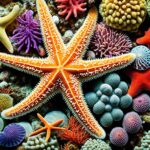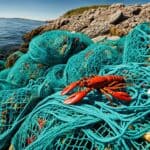Protecting sea turtles is crucial for keeping our oceans healthy. These amazing creatures face many dangers. But, you can help by taking simple steps every day. By learning how to protect sea turtles, you can help save them.
Reducing plastic use and caring for local habitats are key actions. Every choice you make helps protect these endangered animals. Let’s see how your actions can make a big difference for sea turtles and our oceans.
Understanding Sea Turtle Conservation
Sea turtle conservation is key to saving these amazing creatures. Seven types of sea turtles live in our oceans, each facing big challenges. These challenges include habitat loss, climate change, and pollution, which harm their numbers.
Groups around the world work hard to save sea turtles. They do research, restore habitats, and teach people about the dangers. For example, they watch over nesting beaches to keep female turtles safe. Sadly, some sea turtle populations have dropped by more than half in recent decades because of us.
We need to act fast to protect the ocean and its creatures. Healthy sea turtles help keep the ocean full of life by taking care of seagrass beds and coral reefs. By supporting sea turtle conservation, you help protect the ocean and all living things in it.
The Importance of Protecting Endangered Sea Turtles
Sea turtles are key to keeping marine ecosystems healthy. They help grow seagrass, which supports many marine animals. This shows why we must protect them. Many sea turtles are endangered, making it more important to act fast.
Without sea turtles, marine life suffers. Their loss can harm coral reefs and fish populations. Local tourism also suffers when these creatures are gone. People come to see sea turtles, so their loss could mean fewer visitors and less money.

We need to act quickly to save sea turtles. Doing so protects these amazing animals and helps the ocean. Every conservation effort teaches us more about marine life and shows we can all make a difference.
| Sea Turtle Species | Status | Ecological Role |
|---|---|---|
| Leatherback | Critically Endangered | Controls jellyfish populations |
| Hawksbill | Critically Endangered | Maintains coral reef health |
| Green | Endangered | Aids seagrass growth |
| Kemp’s Ridley | Endangered | Regulates crustacean populations |
| Loggerhead | Endangered | Supports marine ecosystem balance |
Knowing how important sea turtles are motivates us to help protect them. Every action we take helps keep the ocean vibrant and strong for the future.
How Can We Protect Sea Turtles?
Protecting sea turtles is crucial, and it starts with your choices. When buying seafood, think about how it affects these amazing creatures. By choosing wisely, you help save sea turtles. Learning about sustainable seafood helps you make a positive impact on the ocean.
Becoming a Responsible Seafood Consumer
When you pick seafood, make sure it’s caught in a way that protects the ocean. Support fishing that uses methods that don’t harm sea turtles. Avoid seafood caught with trawling, as it can trap and kill these turtles.
Learning About Sustainable Seafood Practices
Use tools like the Monterey Bay Aquarium’s Seafood Watch to find safe seafood choices. This guide lists seafood that’s good for the ocean and won’t harm sea turtles. Buying from local fisheries also helps the local economy and supports sustainable fishing.
| Fishing Method | Impact on Sea Turtles | Recommendation |
|---|---|---|
| Hook-and-line | Low risk of bycatch | Preferred method |
| Trawling | High risk of bycatch | Avoid |
| Gillnets | Moderate risk of entanglement | Use cautiously |
By making smart choices and supporting responsible seafood, you help protect sea turtles and their homes. These actions make the ocean healthier for everyone. Every step we take now helps ensure a better future for sea turtles.
Simple Practices to Safeguard Sea Turtle Habitats
Protecting sea turtles is easy with simple actions in your daily life. By doing a few things, you help keep their homes safe and support their survival. Here are some easy ways to make a big difference.
Reduce Marine Debris and Clean Up Beaches
Reducing marine debris is key to helping sea turtles. Join local beach clean-ups to remove trash and plastics that can hurt them. You can also clean up with friends or family, making it fun and meaningful. Every bit of trash you remove helps sea turtles.
Turning Off Lights Visible from the Beach
Turning off lights that shine from the beach is also important. Artificial lights can confuse sea turtles and their babies, making them lose their way to the ocean. By reducing light pollution during nesting season, you help them succeed. Ask your community to do the same for even more impact.
Using Reusable Items to Cut Down on Plastic Waste
Using reusable items is another way to fight plastic waste. Choose bamboo straws, stainless steel water bottles, and cloth bags over disposable ones. These changes reduce trash in the ocean and promote a sustainable lifestyle. By doing this, you’re helping to protect sea turtles and their homes for the future.
FAQ
What are the main threats facing sea turtles?
Sea turtles face threats like habitat loss, climate change, pollution, and bycatch in fishing. These issues lead to a decline in their populations. Many species are endangered or critically endangered.
How can I contribute to sea turtle conservation in my community?
You can help by joining beach clean-ups, using less plastic, and supporting responsible fishing. Also, working with local groups can spread the word and gather support for sea turtle protection.
Why is it important to protect sea turtles?
Sea turtles are key to healthy marine ecosystems. They keep seagrass beds and coral reefs thriving, which supports many marine species. Losing them could harm biodiversity, ecosystem health, and local economies that depend on tourism.
What are some sustainable seafood practices I should be aware of?
Choose seafood from responsible sources. Use guides like the Monterey Bay Aquarium’s Seafood Watch for sustainable choices. Avoid seafood caught with harmful methods, like trawling, which harms sea turtles.
How can I reduce marine debris that harms sea turtles?
To reduce marine debris, join clean-up events, use reusable bags, and cut down on single-use plastics. These actions help protect sea turtle habitats and marine health.
How does artificial lighting affect sea turtles?
Artificial lighting can confuse sea turtles during nesting, leading hatchlings away from the ocean. It’s important to reduce beach lights during nesting season to protect these endangered creatures.
What measures are organizations taking to protect sea turtles?
Groups are working to protect sea turtles through habitat protection, rehabilitating injured turtles, and educating people about safe fishing and marine conservation. Supporting these efforts can make a big difference.







